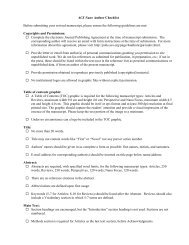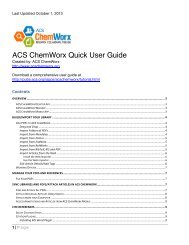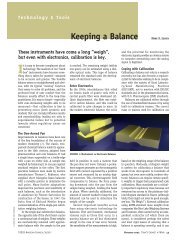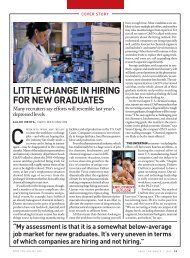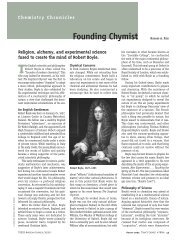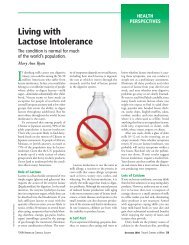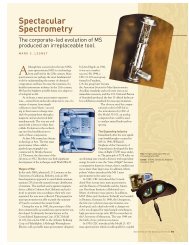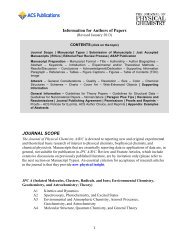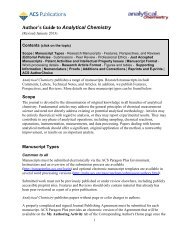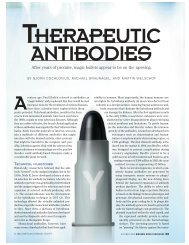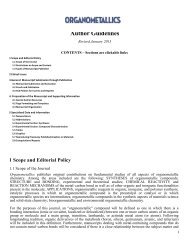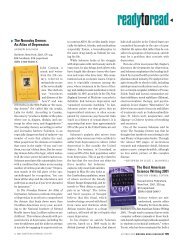Desperately seeking quinine. - American Chemical Society ...
Desperately seeking quinine. - American Chemical Society ...
Desperately seeking quinine. - American Chemical Society ...
Create successful ePaper yourself
Turn your PDF publications into a flip-book with our unique Google optimized e-Paper software.
s<strong>Desperately</strong><br />
<strong>seeking</strong> <strong>quinine</strong><br />
The malaria threat drove the Allies’ WWII<br />
“Cinchona Mission”.<br />
ILLUSTRATION: HUNT INSTITUTE FOR BOTANICAL DOCUMENTATION, CARNEGIE MELLON UNIVERSITY<br />
BY VASSILIKI BETTY SMOCOVITIS<br />
The outbreak of the Second World War<br />
saw Allied troops ill-prepared to deal with<br />
war in malarial zones. By 1942, as Java with<br />
its famous cinchona plantations—and the<br />
largest <strong>quinine</strong> factory in the world, the<br />
Banfoengsche Kininefabriek—fell to Japan,<br />
the Allies found themselves cut off from the<br />
world’s largest producer of <strong>quinine</strong>. The<br />
German Army had already taken over<br />
the world’s main supplier and repository<br />
of processed <strong>quinine</strong> run by the Dutch<br />
Kina Bureau, the cartel that monopolized<br />
<strong>quinine</strong> distillation, when it took over<br />
Amsterdam in 1940.<br />
As World War II spread to the Pacific<br />
theater, more Allied troops fell to malaria<br />
than to Japanese bullets. By December<br />
1942, more than 8500 U.S. soldiers were<br />
hospitalized with malaria. In one hospital,<br />
as many as 8 of every 10 soldiers had<br />
malaria, not war-related injuries. An<br />
Army Air Corps count of hospital admissions<br />
made between November 1942<br />
and February 1943 made a disturbing<br />
projection: If left unabated, in just one<br />
year as many as 4 out of every 10 soldiers<br />
would be hospitalized for malaria alone.<br />
Synthetic antimalarials such as those<br />
that would eventually be trademarked<br />
“Atabrine” were available during the<br />
war. Atabrine had originally been manufactured<br />
by the German industrial giant<br />
I. G. Farben from coal tar in the early 1930s.<br />
But Atabrine lacked the efficacy of <strong>quinine</strong><br />
and caused horrible side effects like nausea,<br />
diarrhea, headaches, and yellow-tinged<br />
skin; if that weren’t bad enough, Japanese<br />
propaganda spread the rumor that it caused<br />
impotence. U.S. troops would go to great<br />
lengths to avoid taking the bitter pill. The<br />
lack of an adequate and stable supply of a<br />
usable antimalarial agent thus became a vital<br />
national security issue. The United States<br />
had failed to stockpile adequate amounts of<br />
<strong>quinine</strong> when it should have. Secretary of<br />
© 2003 AMERICAN CHEMICAL SOCIETY<br />
Commerce Jesse Jones thought the price<br />
of <strong>quinine</strong> was too high. He refused to<br />
secure enough of the drug even though the<br />
Office of Foreign Economic Administration<br />
had ordered him to stockpile strategic military<br />
materiel, including medicines like <strong>quinine</strong>,<br />
along with rubber, nitrates, and tin.<br />
Caught largely unprepared, the United<br />
States entered the Pacific theater without<br />
an adequate amount of the best antimalarial<br />
agent available.<br />
In the United States, significant amounts<br />
of the less desirable Atabrine became available<br />
through Winthrop <strong>Chemical</strong> Company.<br />
Winthrop had been a partner with I. G.<br />
Farben but severed its ties to the German<br />
giant through the Alien Properties Act just<br />
before the bombing of Pearl Harbor. Using<br />
intermediate chemicals imported from<br />
Germany, it was producing some<br />
5 million tablets of Atabrine at the outbreak<br />
of war. Winthrop increased production and<br />
then licensed the production process to<br />
thetimeline<br />
manufacturers without taking royalty fees.<br />
As a result, Atabrine was soon produced by<br />
other pharmaceutical companies, including<br />
Abbott, Lilly, Merck, and Frederick<br />
Stearns. Intermediates that were no longer<br />
available from Germany were supplied by<br />
chemical companies such as Harmon Color<br />
Works, Hilton Davis, the National Aniline<br />
Division of the Allied <strong>Chemical</strong> and Dye<br />
Corporation, and the Pharma <strong>Chemical</strong><br />
Company. As a result of the concerted<br />
effort, the U.S. wartime production of<br />
Atabrine in 1944 reached 3.5 billion tablets.<br />
But the troops refused to take it.<br />
Drastic conservation measures for<br />
<strong>quinine</strong> were adopted at home. The War<br />
Production Board restricted the use of<br />
<strong>quinine</strong> and other antimalarials to the<br />
treatment of malaria. But it was clear that<br />
such actions were not enough.<br />
In response to the crisis, the United<br />
States began a massive effort to provide<br />
<strong>quinine</strong> to <strong>American</strong> troops. The best<br />
option appeared to be to procure species<br />
native to Andean South America and<br />
then to cultivate plantations of the highest-yielding<br />
crops. In April 1942, <strong>quinine</strong><br />
procurement was placed under the<br />
control of the Board of Economic<br />
Warfare, a U.S. government wartime<br />
agency that had charge of the accumulation<br />
of strategic materials. Shortly<br />
thereafter, what became known as the<br />
Cinchona Mission was established under<br />
the Board of Economic Warfare with<br />
the cooperation of the Department of<br />
Agriculture and the National Arboretum.<br />
William C. Steere, a botanist from the<br />
University of Michigan, and F. Raymond<br />
Fosberg, a botanist with the Department<br />
of Agriculture, were enrolled to help organize<br />
the procurement process.<br />
The principal cinchona-producing countries<br />
of the 19th century were approached,<br />
and “cinchona agreements” were drafted.<br />
The countries agreed to “sole buying privileges”<br />
for all cinchona bark if it had a fixed<br />
minimum total crystallizable alkaloid content,<br />
which varied from 2 to 3% minimum.<br />
The countries agreed to give technical aid<br />
in the exploration and procurement of cin-<br />
MAY 2003 MODERN DRUG DISCOVERY 57<br />
d
dthetimeline<br />
chona, and in return the United States was<br />
expected to establish a permanent cinchona<br />
plantation program in the host country.<br />
The first procurement team left in the fall<br />
of 1942 for Colombia, which had been the<br />
chief provider of <strong>quinine</strong> in the 19th century.<br />
Cinchona missions were then established<br />
in Peru and Ecuador, but Bolivia, the<br />
first source of <strong>quinine</strong>-rich bark, never ratified<br />
the agreement. It had agreed to send<br />
its cinchona bark to the Dutch Kina Bureau<br />
instead. Nevertheless, the Board of<br />
Economic Warfare established agents in La<br />
Paz to arrange for the purchase of surplus<br />
<strong>quinine</strong> and <strong>quinine</strong> bark. Besides the<br />
agreements with those countries in which<br />
cinchona trees are native, agreements were<br />
made with Costa Rica and Guatemala.<br />
Cinchona plantation programs had been initiated<br />
as early as 1934 by the pharmaceutical<br />
company Merck, which had explored<br />
the cultivation of cinchona plantations in<br />
Guatemala in an attempt to gain control of<br />
the Dutch monopoly in Java. Its nurseries<br />
and laboratory became enrolled in the<br />
wartime procurement effort.<br />
The work of the cinchona missions<br />
involved hunting for the <strong>quinine</strong>-rich strains<br />
first found in the Andes. The survey teams<br />
consisted of a botanist, a forester, and local<br />
Latin assistants who were to be trained in<br />
the collection of cinchona. At their peak, the<br />
cinchona missions involved as many as 30<br />
<strong>American</strong> botanists. For more than two<br />
years, beginning in 1942, these teams traversed<br />
known cinchona regions of the<br />
Andes, finding, in addition, several previously<br />
unknown bark areas.<br />
Botanists on the team were expected to<br />
identify and collect cinchona. They also collected<br />
related Rubiaceous genera that might<br />
prove useful in breeding programs. The<br />
task of the foresters was procurement, estimation<br />
of bark volume, and determination<br />
of best harvesting procedure. Once procured,<br />
the bark was transported back to one<br />
of the field laboratories in Bogotá, Colombia;<br />
Quito, Ecuador; Lima, Peru; or La Paz,<br />
Bolivia. The work was arduous. Indian packmen<br />
or bark-cutters called cascarilleros<br />
were hired to transport 40–80 lb of the bark<br />
on their backs along narrow trails.<br />
Occasionally, mules were used to transport<br />
bark to the nearest rivers for further transport.<br />
Landing strips were sometimes built<br />
58 MODERN DRUG DISCOVERY MAY 2003<br />
so that the bark could be airlifted. Detailed<br />
reports were produced, which included<br />
geographical data of the cinchona areas<br />
where plantation development was desirable<br />
and feasible, and other commercial information<br />
valuable in addressing the immediate<br />
problem of harvesting and transportation.<br />
Collection was more difficult than anyone<br />
had realized. Cinchona frequently<br />
hybridized with diverse strains and with<br />
numerous varieties that contained varying<br />
amounts of alkaloids. <strong>Chemical</strong> tests<br />
soon determined that there were variations<br />
in type and amount of the alkaloid in<br />
Cinchona, the source<br />
of <strong>quinine</strong> and other<br />
antimalarial alkaloids, is<br />
an evergreen tree<br />
(genus Cinchona) native to<br />
mountainous areas of South<br />
and Central America. The tree<br />
was named for the Spanish<br />
Countess of Chinchón, said<br />
to have been cured of a fever<br />
in 1638 by a preparation<br />
of the bark.<br />
individual plants based on their location.<br />
Barks were classified into good bark and<br />
bad bark, depending on their usefulness,<br />
but quick and easy tests based on color or<br />
taste quickly proved unreliable. Many of the<br />
botanists, too, had never seen tropical<br />
plants in situ, let alone been trained to<br />
quickly identify such a complex genus.<br />
The <strong>American</strong> foresters were equally baffled;<br />
they could easily recognize their own<br />
native trees but initially had a hard time recognizing<br />
and working with cinchona. Nor<br />
could the local people easily recognize the<br />
plants. Despite some residual harvesting of<br />
bark in Colombia and Ecuador before the<br />
wartime need, the local people lacked special<br />
skills at stripping or shipping the bark.<br />
To prepare the botanists, foresters, and<br />
local collectors and to help train a permanent<br />
staff, Department of Agriculture<br />
botanist Fosberg wrote The Cinchona<br />
Manual and translated it into Spanish.<br />
Other problems ensued. The survey<br />
teams encountered hostile local peoples.<br />
Rivalries soon broke out among the local<br />
collectors, the landowners, and government<br />
collecting agencies. Easily accessible<br />
trees were soon harvested, and botanists<br />
had to survey more and more remote areas.<br />
The botanists experienced altitude sickness<br />
at collecting sites as high as 11,000 ft<br />
and suffered from the high humidity, which<br />
rotted their clothes and damaged their<br />
instruments. They also suffered from malnutrition,<br />
amoebic dysentery, and even<br />
malarial fevers. One botanist, Arthur<br />
Feathersonhaugh, died of a heart attack<br />
induced by the high altitude. His body was<br />
carried on a stretcher in a dangerous trek<br />
down a precipitous slope.<br />
The botanists hunted for two years.<br />
Then, in 1944, synthetic <strong>quinine</strong> (in a nonstereoselective<br />
mixture) was synthesized<br />
from precursors by two <strong>American</strong> scientists,<br />
William E. Doering of Columbia University<br />
and Robert B. Woodward of Harvard<br />
University. Although it was not made available<br />
for commercial purposes, it eventually<br />
led to more synthetic drugs that, although<br />
lacking the ability to cure malaria, were able<br />
to control various stages of the disease. As<br />
a result of the improvement of such synthetic<br />
antimalarial agents, the U.S. cinchona<br />
missions returned home at the end<br />
of 1944, after having shipped back some 12.5<br />
million lb of cinchona bark. In November<br />
1945, all agreements with the South<br />
<strong>American</strong> governments for the collection<br />
of bark were terminated. Overall, the cinchona<br />
missions met with mixed success.<br />
They provided a significant quantity of cinchona<br />
for the Allied war effort, but they<br />
were never able to locate the high-<strong>quinine</strong>yield<br />
species Cinchona ledgeriana.<br />
Editors’ note: Gilbert Stork and co-workers<br />
completed the first total stereoselective synthesis<br />
of <strong>quinine</strong> in 2001.<br />
Sources<br />
Hodge, W. H. Econ. Bot. 1947, 1–2, 229–257.<br />
Howard, R. A. Bot. Rev. 1994, 69, April–June,<br />
197–257.<br />
Rosengarten, F. History of the Cinchona Project of<br />
Merck and Co., Inc. and Experimental<br />
Plantations, 1934–1949; Merck: Rahway, NJ,<br />
1944.<br />
Worthen, D. B. Pharmacy in History 1996, 38,<br />
143–147.<br />
This article is adapted from Today’s Chemist<br />
at Work, 2000, 1, 69–72.<br />
Vassiliki Betty Smocovitis is an associate professor<br />
in the department of history at the<br />
University of Florida. Send your comments or<br />
questions about this article to mdd@acs.org<br />
or to the Editorial Office listed on page 3. o



